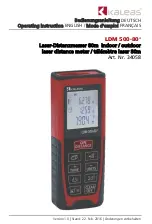
Section 4: Multi-frequency capacitance-voltage unit
Model 4200A-SCS Parameter Analyzer Reference Manual
4-58
4200A-901-01 Rev. C / February 2017
The series resistance, R
S
, may be calculated from the capacitance and conductance values that are
measured while biasing the DUT (device under test) in the accumulation region. The series
resistance is calculated as follows:
Where:
•
R
S
= series resistance
•
G = measured conductance
•
C = measured parallel model capacitance (in strong accumulation)
•
f = test frequency as set in Clarius
The above equations for compensating for series resistance require that the 4210-CVU is using the
parallel model (Cp-Gp).
In this project, these formulas have been added into the Clarius Formulator so the capacitance and
conductance can be automatically compensated for the series resistance.
Extracting MOS device parameters from C-V measurements
The following topics describe how MOS device parameters are extracted from C-V measurements.
Oxide thickness
For a relatively thick oxide (>50Å), the oxide capacitance (C
OX
) is the high-frequency capacitance
when the device is biased for strong accumulation. In the strong accumulation region, the MOS
capacitor acts like a parallel-plate capacitor, and the oxide thickness (T
OX
) may be calculated from
C
OX
and the gate area using the following equation:
Where:
•
T
OX
= oxide thickness (nm)
•
A = gate area (cm
2
)
•
ε
OX
= permittivity of the oxide material (F/cm)
•
C
OX
= oxide capacitance (F)
•
1 x E
7
= units conversion from cm to nm
















































